
Best violins for serious violin players We’ve listed beginner violins in another post; here we have listed top-quality violins with better build quality, durability and tonal qualities. Many of these are concert-ready instruments suitable for professional musicians.
Introduction
Violin is a beautiful orchestral instrument that is used in almost all classical music, and has been inspiring classical musicians and audiences for centuries; the violin can also be used in folk and other genres of music.
Violins are string instruments, like the viola and cello, but much smaller in size (and has high pitch ranges).
A lot of students who wish to be or are part of the school band wish to learn to play the violin.
Violins come in different sizes – 4/4, 3/4, 1/2, 1/4, 1/8, 1/10, 1/16 and 1/32 violins to cater to students of various ages. The neck-to-wrist length of the student will give an idea of what size will be the most comfortable for the student.
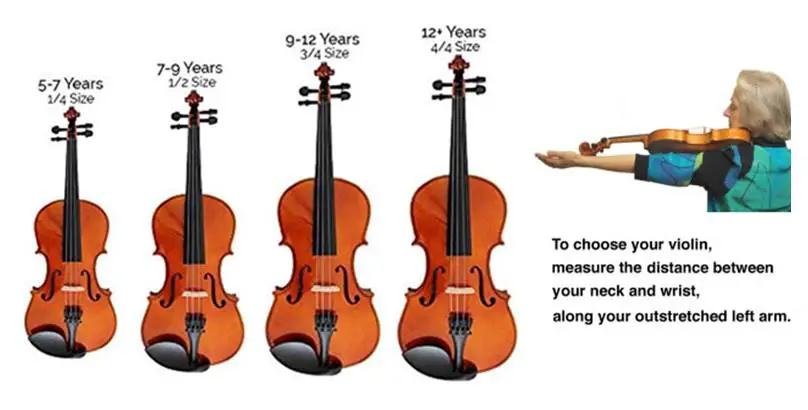
A violin with better construction, quality and workmanship, is what a serious player needs, as it’s going to make a lot of difference to the tonal quality and playability.
Here, we have listed violins for beginners as well as for the more experienced (professional) players.
Best Violins: Reviews
Here we take a look at the best violin for beginners that are affordable (compared to their professional counterparts) yet have nice tonal qualities and more importantly are high on playability.
Popular violin brands preferred by beginners and intermediate students include Cecilo, Mendini, Cremona, Stentor, Knilling; you can also consider instruments from Shar Music or Southwest Strings, both are specialized in string instruments.
Few models listed here are promoted as beginner violins, but with the right strings and rosin, they can also be played by intermediate violin players.
These violins are completely set-up and ready to be played; no assembly is required.
Violin for Beginners
Bunnel Pupil Violin Outfit 4/4 (Full) Size (by Kennedy Violins)
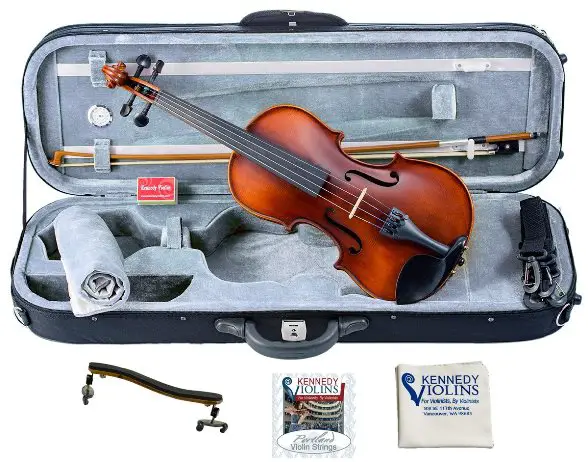 This is a nice violin for beginners – well built, and affordable. You are unlikely to find a violin at this price point that is actually playable.
This is a nice violin for beginners – well built, and affordable. You are unlikely to find a violin at this price point that is actually playable.
The violin is well constructed and produces a rich tone. Hand carved violin is made from solid spruce and solid maple, has a solid spruce front and a solid maple back, neck and sides. It comes with steel-core D’Addario Prelude Strings.
BOW FEATURES: High-grade Brazilwood stick, Real Mongolian horse hair, high-grade ebony. You also get additional accessories such as Oblong case w/ straps, music pocket, accessory compartments & YKK zippers, shoulder rest, Kennedy Violins natural rosin.
Kennedy Violins Ricard Bunnel G2 Violin
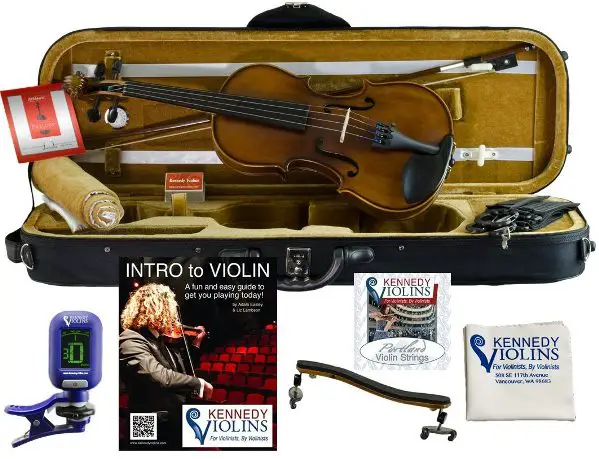 Ricard Bunnel G2 Violin is a beautiful mid-range instrument that sounds full, looks great, and comes with useful accessories, suited to intermediate players and serious beginners. It’s available in all possible sizes. Great for practice and an excellent choice for devoted students.
Ricard Bunnel G2 Violin is a beautiful mid-range instrument that sounds full, looks great, and comes with useful accessories, suited to intermediate players and serious beginners. It’s available in all possible sizes. Great for practice and an excellent choice for devoted students.
It comes with everything you need to start playing the violin – violin with case, bow, rosin and strings. The violin comes with the D’Addario Prelude strings, which is a nice set for beginners, but as your skills grow, you may yearn for something deeper and warmer. Intro to violin book included, backed by lifetime warranty, Weight: 7.3 pounds.
Although a beginner violin, it can be used by intermediate level players as well.
High-quality bow, with real Mongolian horse hair for a smooth and fuller tone.
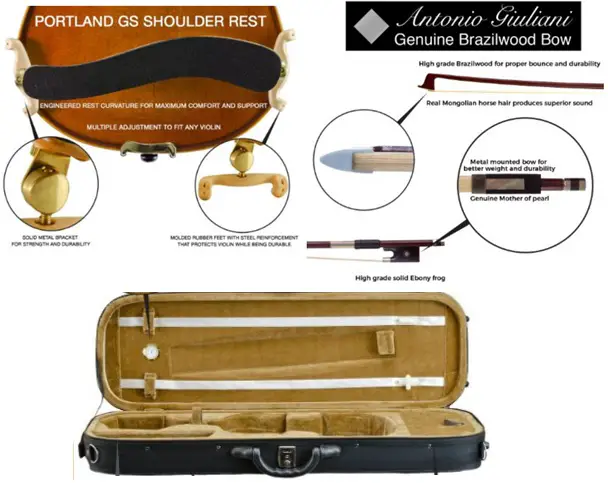
Mendini 4/4 MV500+92D violin
Mendini violins are great for beginners, they are affordable and come with a reasonable build quality, allows you to learn without investing a lot of money. The Mendini MV series is a popular series of violins for beginners and intermediate players.
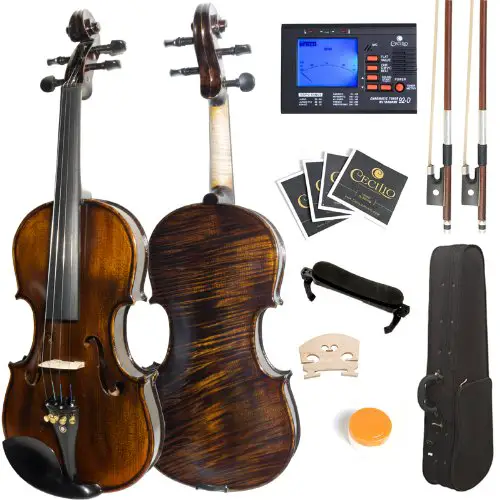 The Mendini 4/4 MV500+92D is an entry-level violin that will help your child achieve mid-range grades before the time comes to invest in a higher quality model.
The Mendini 4/4 MV500+92D is an entry-level violin that will help your child achieve mid-range grades before the time comes to invest in a higher quality model.
It is carved out of one piece of maple wood. It comes with all the necessary accessories like Case, Tuner, Shoulder Rest, Bow, Rosin, Bridge and Strings.
Accessories included – Cecilio 92D chromatic / string tuner with metronome, 2 x Brazil wood bows with unbleached genuine Mongolian horsehair, lightweight hard case, adjustable shoulder rest, 2 bridges, quality rosin, and an extra set of violin strings.
Its better to put new set of strings on the violin once you get it. The strings that come along may not sound that great. Once setup, the violin sounds great. The bows are okay, and you may need to buy new rosin.
Overall, this is a great instrument. The Mendini 4/4 MV500+92D comes across as a bit more expensive instrument (Mendini’s usually target beginners and are cheaper) for a student violin, but this will help your child achieve higher levels and perhaps even advance to a professional violin player level.
Stentor Violins
Stentor makes some of the best student violins; the Stentor 1550 model is a nice violin for beginners, it produces good sound, is easy to play and often recommended by violin teachers.
- Stentor 1550: 4-String Violin (4/4 full size)
Violins for Professionals
These are high-quality violins, handcrafted with quality wood that is seasoned for years; they use authentic parts, and are also backed by a lifetime warranty. These are ready to play and include accessories such as case, bow, rosin, and strings.
Kennedy Violins Louis Carpini G2
Kennedy Violins Louis Carpini G2 is a full size professional violin handcrafted with solid maple and spruce tonewoods, 100% genuine ebony fittings, and oil finish. Outfit includes everything you need: professional hard-shell case, genuine Brazilwood bow, rosin, and D’Addario Prelude strings.
Well built, smooth and warm tone with beautiful resonance. You will love the rich sound of the violin and the beautiful flaming on these violins.
It comes with a hard-shell case with a built-in hygrometer that can measure the moisture level in the environment.
It is backed by a lifetime warranty, Weight 11.5 pounds.
Cecilio CVN-600
The Cecilio CVN-600 is a one-piece full-size violin with maple back and sides, and solid grained spruce top. The violin looks beautiful, the varnish of the violin is excellent, and it’s quite affordable considering its build quality. It comes with D’Addario Prelude Strings.
You may have to upgrade the strings, the bows, the bridge, and rosin, but even that upgrade is going to cost you just over 100 bucks. If you upgrade these things, this beautiful violin will sound amazing.
The bundle includes chromatic tuner, oblong case with hydrometer, 2 x Brazilwood bows with unbleached genuine Mongolian horsehair, quality rosin cake, adjustable shoulder rest, and an extra bridge.
Electric Violins
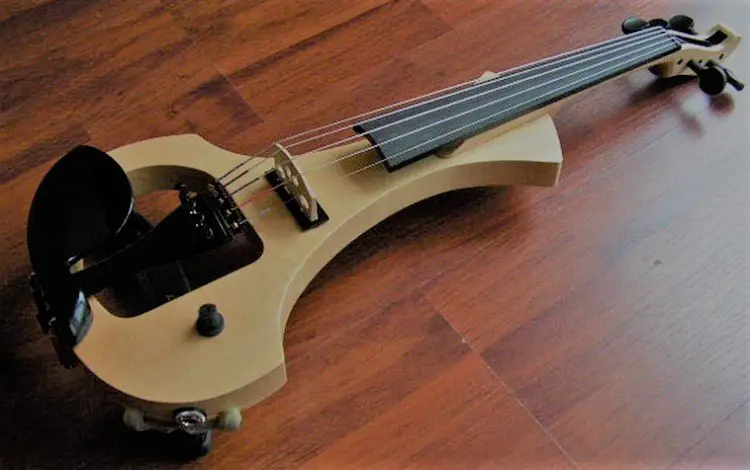 The main advantage of an electric violin (“silent” violin) is that it allows you to practice in silence, and it can also be easily connected to amplifiers and PA.
The main advantage of an electric violin (“silent” violin) is that it allows you to practice in silence, and it can also be easily connected to amplifiers and PA.
An electric violin has a pickup built into the body that picks up the vibrations of the strings and sends it to the amplifier. To avoid feedback caused by resonance in the violin’s hollow body, electric violins usually have solid body design, and often have simple designs to reduce weight.
The sound produced on these instruments can be altered using effect pedals to add distortion, echo, delay, and more.
The traditional acoustic violin produces a warm, rounded tone thanks to the natural resonance of its tonewoods. Classical and folk musicians usually prefer acoustic violins, whereas rock and jazz musicians opt for electric violins.
In case you’re a beginner, I would suggest you go in for a decent acoustic violin.
Buying Guide
When looking for a violin for the younger students, here are the things that you should keep in mind:
Size of the Violin
When choosing a violin, you should consider the age of the student and the size of their hands and finger strength. In general, for beginners, smaller is often better than bigger.
The simplest way to determine if a violin is comfortable for the child is to do the following: Ask the child to place the violin on the shoulder and ask the child to reach their left hand up around the scroll. The child should be able to do this comfortably with a bent elbow.
Type of Strings
Any string instrument is not easy on the fingers for a beginner, more so if the instrument is fitted with steel strings, which can be hard on little fingers.
Even if the violin you buy comes with steel strings, you should consider replacing the strings with non-metal core ones (available from D’Addario, Corelli, Larsen, Thomastik, Pirastro). The change of strings will be well worth it.
Read: Learn to play violin: Useful tips.
Violin Construction
Violin is a hollow stringed instrument with a long neck and four strings tuned from low to high (each note is a perfect fifth to the one below it).
A violin can be tuned by turning the pegs or fine tuners on the tail piece. The fine tuners allow for slight adjustments to the tensions of the strings.
The sound produced by the violin depends mainly on its wood and varnish.
Violin strings today are made out of different materials — metal, synthetic core or gut strings.
Metal violin strings produce clear and loud tones and are easier to play. Beginners and intermediate players usually prefer steel core strings.
Synthetic core violin strings are made of nylon/perlon and produce subtler sounds than metal strings and don’t have to be tuned often.
Violinists often carry spare supply of strings (just in case).
A violin is usually played using a bow consisting of a stick with a ribbon of horsehair strung between the tip and frog (or nut, or heel) at opposite ends. Usually, the hair of a violin bow is made from the tail of a mail horse (cheaper violins now use plastics or synthetics).
There is also a leather grip at one end with winding to protect the stick and provide thumb rest for the player. The winding can be made up of whale bone but most manufacturers now use fiber glass.
How are professional violins different from beginner violins?
Professional violins (like any professional instrument) are constructed from highly-quality materials and parts, have a high level of craftsmanship, are sturdy and durable, feel extremely good in the hands, and above all, they sound excellent.
However, they are expensive (cost a few thousand dollars) and also require more maintenance.
Violins for intermediate level players borrow a bit of everything from the professional-grade violins in order to appeal to students with a few years of experience (and who are not professionals yet).
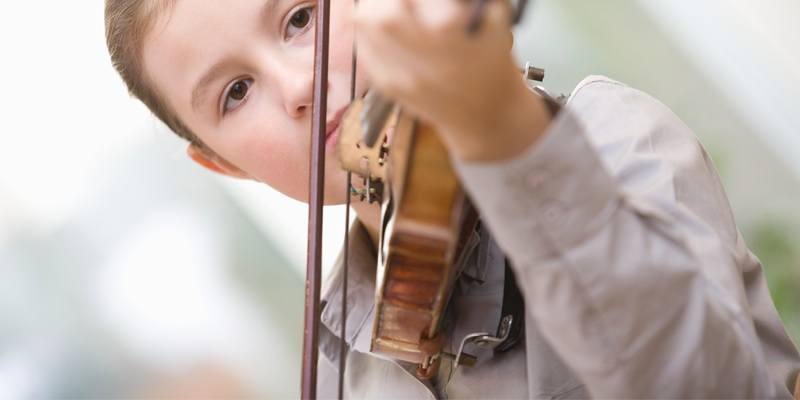
Why older violins sound better
Over time, a violin starts sounding better (or more consistent) as the wood gets sufficient time to adjust to the environment and naturally seasons. Some violins can take several months to reveal its true sound.
If you hear a used violin that has been maintained well, you can hear that they have a distinct sound.
So if you can find a good quality old violin at a bargain, go for it.

Violin Care and Maintenance
Like most other musical instruments, you will need to take care of our violin to make sure it lasts for years. Here are a few products & accessories you may need to take proper care of your violin.
- Strings: Depending on how much you play, you may need to change the strings of your violin every six to 12 months.
- Violin Case: Offers protection while traveling, makes it easy to transport your violin, bow, rosin.
- Cleaning Supplies: Like other musical instruments, you need to kept your violin free of dirt and dust. You get a wide range of cleaning and care supplies for violins.
- Humidifier: Because these are made of wood, humidity could damage the tonewoods. So if you live in a dry area, you need to consider buying an instrument humidifier.
Violin manufacturers recommend that you avoid situations where the violin is in direct or extended exposure to sunlight, rain, heaters, air conditioners for longer periods.
Here are some more suggestions to maintain your violin:
- Avoid humidity and extreme temperatures.
- Monitor for cracks on your violin. If they are bad, take it for repair.
- Take care of your violin bow. Every time you use your bow, loosen it before putting it back into the case. Get it restrung at least twice a year.
- Make sure you buy a violin case as well in order to protect your instrument from any damage.
Useful Links
Ben took formal violin lessons for 10 years when he was in school; he writes on violin and other string instruments, and contributes towards the growth of this site. Read more here.



I would NOT recommend any of these violins, except the Knilling violin. These inexpensive violins are actually cheap student violins that will not produce the best tone, simply because they are made from poor quality woods. The price might be very tempting but you will get what you pay for. Most of these violins are not built to professional standards – pegs not fitted, nut and bridge too high, fingerboards not smooth or shaped correctly, poor quality strings and tailpieces. The bows that come with these outfits are very poor quality and usually too heavy and crooked. I would suggest that you do not go for the cheapest violin. The more expensive violins come with a good bow, good set of strings, and proper setup.